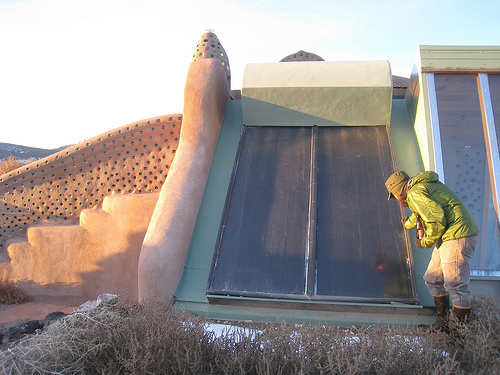Water is heated with the sun and natural gas. The sun heats the water and the natural gas water-heater only turns on if the water is not hot enough. This is called “gas-on-demand” water heating.
Plumbing lines from the WOM go into a solar hot water heater. Then the plumbing lines go to a heating unit water heater, like a gas or propane water heater. This is an ‘on-demand’ water heater. This water heater that uses fuel only goes on if the water is not hot enough (from solar heating). In areas that get enough sun, the fueled ‘on-demand’ water heater is seldom used.
The fueled ‘on-demand’ water heating unit has another good design to be aware of. The water is channeled through a radiator like system and has a sensor so the flame only goes on when the water is moving. When the water is not running, only a small pilot light is on. This results in a very good efficiency rating.
Water is heated from the sun, biodiesel and/or natural gas.
Solar water heating collectors capture and retain heat from the sun and transfer this heat to a liquid. Solar thermal heat is trapped using the “greenhouse effect,” in this case is the ability of a reflective surface to transmit short wave radiation and reflect long wave radiation. Heat and infrared radiation (IR) are produced when short wave radiation light hits a collector’s absorber, which is then trapped inside the collector. Fluid, usually water, in contact with the absorber collects the trapped heat to transfer it to storage.
Two principles govern solar thermal collectors. First, any hot object eventually looses its heat back to the environment. The efficiency of a solar thermal collector is directly related to heat loss, mainly from convection and radiation. Thermal insulation is used to slow down heat loss from a hot object to its environment.
Second, heat loss is more rapid if the temperature difference between a hot object and its environment is larger, in this case between the temperature of the collector surface and the ambient temperature. (But the same goes for transferring heat from the collector to the fluid, a larger difference between the collector and the liquid, the more heat is transferred.)
The most basic approach to solar heating of water is to simply put a tank filled with water into the sun. The heat from the sun would heat the metal tank and the water inside. This was how the very first SWH systems worked more than a century ago. However, this setup would be inefficient because there is little to limit the heat loss from the tank. Adding an insulated box around the tank, and adding glass above the top where the sun comes in would do a lot to retain heat.
A more common collector is called a flat plate collector. It has a large, flat surface area (absorber) to maximize exposure to the sun, and has small tubes bonded to it. Fluid runs through the tubes, collecting the heat from the absorber. The sides and bottom of the collector are well-insulated, and glass on top completes the insulation.
This is quite simple, but there are some very technical factors involved in making the collector as efficient as possible. One is the coating on the absorber, which is specially formulated to both absorb as much heat as possible, and to radiate back out as little heat as possible. Another is the glass, which is high-iron and specially coated to let as much light energy as possible through and to also prevent as much heat loss as possible.
Another popular type of collector is called evacuated tube, which has a long, skinny absorber that is inside a glass tube. The tube has the air evacuated out of it, which makes it highly insulated—not too different from a thermos used to keep drinks hot.
The final type of collector is a parabolic dish or tray, which increases heat potential by concentrating sunlight onto a small absorber. These are very rare in home water heating systems, and more commonly used in utility-scale systems to create steam which runs turbines to make electricity.
The basic components in home solar heating systems include:
– Collectors to take the heat from the sun and pass it to a fluid
– The heat transfer fluid which takes the heat from the collector for use or storage
– Heat exchangers to transfer the heat from the fluid to a home’s domestic water.
– Pumps to move the fluid through the collector and/or the exchanger, and sometimes to move the domestic water through the other side of the exchanger.
– Controllers to run the pumps when there is collector heat available.
Off-Grid Living Systems
Water | Power | Waste Water Treatment | Heating/Cooling
The systems of a building. These are the systems that go into the structural shell of the building for occupancy. Some or all of these systems can be used instead of the conventional methods to provide utilities to buildings. This can make the build more sustainable, secure and healthy than only using conventional utilities.
All systems can have automated conventional backups. All systems can be added to existing conventional buildings as a renovation project.
Living with sustainable off-grid systems enhances our lives, secures our lives and is a better investment than conventional buildings.
This increases both psychological and physiological comfort.




Leave A Comment